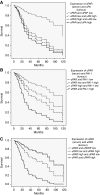Co-detection of members of the urokinase plasminogen activator system in tumour tissue and serum correlates with a poor prognosis for soft-tissue sarcoma patients
- PMID: 20051950
- PMCID: PMC2837565
- DOI: 10.1038/sj.bjc.6605520
Co-detection of members of the urokinase plasminogen activator system in tumour tissue and serum correlates with a poor prognosis for soft-tissue sarcoma patients
Abstract
Background: The urokinase plasminogen activator (uPA) system is one of the best-investigated protease systems, both under physiological and pathological conditions, including various types of cancer. However, effects of co-expression of members of the uPA system in soft-tissue sarcoma (STS) patients at the protein level in both tumour tissue and serum have not been investigated yet.
Methods: We examined 82 STS patients for protein levels of uPA, PAI-1and uPAR in tumour tissue and serum by ELISA.
Results: A significant correlation between high antigen levels of uPA, PAI-1 or uPAR in tumour tissue, and of uPAR in serum, with poor outcome of STS patients was found for the first time. Most strikingly, we observed an additive effect of combined uPA, PAI-1 or uPAR levels in tumour tissue extracts with uPAR levels in serum on patients' prognosis. High uPA/uPAR, PAI-1/uPAR and uPAR/uPAR antigen levels in tumour tissue/serum were associated with a 5.9-fold, 5.8-fold and 6.2-fold increased risk of tumour-related death (P=0.003, 0.001 and 0.002, respectively) compared with those patients who displayed low levels of the respective marker combination.
Conclusion: As expression of members of the uPA system in tumour tissue and serum is additively correlated with prognosis of STS patients, our results suggest that combinations of these biomarkers can identify STS patients with a higher risk of tumour-related death.
Figures

Similar articles
-
Combined mRNA expression levels of members of the urokinase plasminogen activator (uPA) system correlate with disease-associated survival of soft-tissue sarcoma patients.BMC Cancer. 2011 Jun 25;11:273. doi: 10.1186/1471-2407-11-273. BMC Cancer. 2011. PMID: 21702998 Free PMC article.
-
Prognostic impact of urokinase-type plasminogen activator system components in clear cell renal cell carcinoma patients without distant metastasis.BMC Cancer. 2014 Dec 18;14:974. doi: 10.1186/1471-2407-14-974. BMC Cancer. 2014. PMID: 25519168 Free PMC article.
-
Prognostic implications of the co-detection of the urokinase plasminogen activator system and osteopontin in patients with non-small-cell lung cancer undergoing radiotherapy and correlation with gross tumor volume.Strahlenther Onkol. 2018 Jun;194(6):539-551. doi: 10.1007/s00066-017-1255-1. Epub 2018 Jan 16. Strahlenther Onkol. 2018. PMID: 29340706 English.
-
The urokinase plasminogen activation system in gastroesophageal cancer: A systematic review and meta-analysis.Oncotarget. 2017 Apr 4;8(14):23099-23109. doi: 10.18632/oncotarget.15485. Oncotarget. 2017. PMID: 28416743 Free PMC article.
-
uPA/uPAR and SERPINE1 in head and neck cancer: role in tumor resistance, metastasis, prognosis and therapy.Oncotarget. 2016 Aug 30;7(35):57351-57366. doi: 10.18632/oncotarget.10344. Oncotarget. 2016. PMID: 27385000 Free PMC article. Review.
Cited by
-
Prognostic impact of mRNA levels of osteopontin splice variants in soft tissue sarcoma patients.BMC Cancer. 2012 Apr 2;12:131. doi: 10.1186/1471-2407-12-131. BMC Cancer. 2012. PMID: 22471890 Free PMC article.
-
Prognostic significance of the urokinase plasminogen activator system in tissue and serum of dogs with appendicular osteosarcoma.PLoS One. 2022 Sep 29;17(9):e0273811. doi: 10.1371/journal.pone.0273811. eCollection 2022. PLoS One. 2022. PMID: 36174075 Free PMC article.
-
Significance of coagulation and fibrinolysis markers for benign and malignant soft tissue tumors.BMC Cancer. 2021 Apr 7;21(1):364. doi: 10.1186/s12885-021-08091-1. BMC Cancer. 2021. PMID: 33827473 Free PMC article.
-
Elevated levels of serum urokinase plasminogen activator predict poor prognosis in hepatocellular carcinoma after resection.BMC Cancer. 2019 Dec 2;19(1):1169. doi: 10.1186/s12885-019-6397-3. BMC Cancer. 2019. PMID: 31791275 Free PMC article.
-
Modulation of u-PA, MMPs and their inhibitors by a novel nutrient mixture in pediatric human sarcoma cell lines.Int J Oncol. 2013 Oct;43(4):1027-35. doi: 10.3892/ijo.2013.2031. Epub 2013 Jul 23. Int J Oncol. 2013. PMID: 23900236 Free PMC article.
References
-
- Abendstein B, Daxenbichler G, Windbichler G, Zeimet AG, Geurts A, Sweep F, Marth C (2000) Predictive value of uPA, PAI-1, HER-2 and VEGF in the serum of ovarian cancer patients. Anticancer Res 20: 569–572 - PubMed
-
- Brünner N, Nielsen HJ, Hamers M, Christensen IJ, Thorlacius-Ussing O, Stephens RW (1999) The urokinase plasminogen activator receptor in blood from healthy individuals and patients with cancer. APMIS 107: 160–167 - PubMed
-
- Choong PF, Fernö M, Akerman M, Willén H, Långström E, Gustafson P, Alvegård T, Rydholm A (1996) Urokinase-plasminogen-activator levels and prognosis in 69 soft-tissue sarcomas. Int J Cancer 69: 268–272 - PubMed
-
- Clark JC, Dass CR, Choong PF (2008) A review of clinical and molecular prognostic factors in osteosarcoma. J Cancer Res Clin Oncol 134: 281–297 - PubMed
-
- Dass CR, Choong PF (2008) uPAR mediates anticancer activity of PEDF. Cancer Biol Ther 7: 1262–1270 - PubMed
Publication types
MeSH terms
Substances
LinkOut - more resources
Full Text Sources
Medical
Research Materials
Miscellaneous

